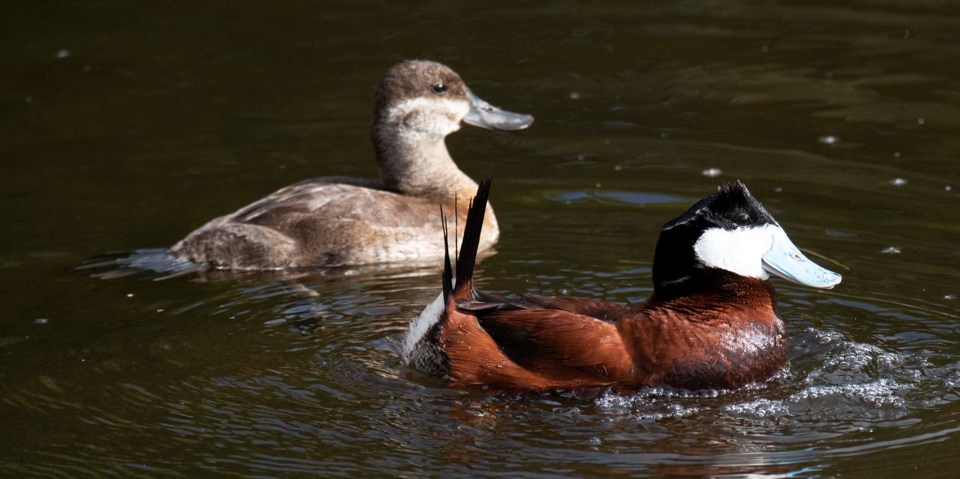Ornithologists will flock to Lois Hole Park this weekend for a celebration of dark skies and migratory birds.
The Big Lake Environment Support Society (BLESS) is holding its 2022 World Migratory Bird Day event this Saturday at Lois Hole Centennial Provincial Park. The free event celebrates the return of thousands of migratory birds to Big Lake and is celebrated worldwide on the second Sunday of May. (It is also observed on the second Sunday in October for the fall migration.)
This is the first time BLESS has been able to hold this event since 2019, said co-organizer Lyn Druett — the COVID-19 pandemic cancelled the 2020 edition and delayed last year’s event to September.
“This year we’re hoping for a brand new start,” she said.
Guests at this year’s event can go pond dipping to find water bugs, assemble crafts with Nature Alberta, and see Alberta Environment’s new trail map signs for Lois Hole Park. Ducks Unlimited and other nature groups will also have displays in the park’s shelter.
Guests can also head out to the BLESS platform to spot birds. Druett said a lengthy list of migrants have returned to the Big Lake region in recent weeks, including red-winged blackbirds, northern shovelers, and great blue herons. Ornithologist Brian Orr will be at the platform to help guests identify any birds they see.
Druett encouraged guests to come out and learn more about the park, the lake, and birds, noting that she has seen many more people take an interest in Big Lake since the pandemic.
The event runs from 10 a.m. to 4 p.m. on May 14. Visit the BLESS Facebook page for details.
Fliers by night
Druett said the theme for this year’s Migratory Bird Day (as declared by Environment for the Americas) is “Dim the Lights for Birds at Night.” Saturday’s event will include displays on how light pollution affects birds at nighttime.
“Some birds do migrate at night,” Druett said, and bright lights can confuse them.
Environment for the Americas has listed 11 ambassador species to illustrate how light pollution affects birds, Druett noted — four can be found at Big Lake. The ruddy duck (known for its ridiculous blue beak and bubble-blowing drumming) can be pulled off course into buildings by night lights, for example, while reflected night lights can stop the black-crowned night-heron from spotting prey underwater.
Most birds migrate at night to avoid predators and take advantage of the cooler, calmer air, using the starts, setting sun, and magnetic fields to navigate, said Carrie Ann Adams, a PhD ecology student at the University of Alberta who studies light pollution.
While researchers have known about the harmful effects of light pollution on migratory birds since the 1800s (the thousands of birds smacking into lighthouses made it obvious), Adams said they have yet to figure out the cause. Bright lights may be confusing the birds, causing them to alter their flight paths and fly toward (and into) buildings.
Adams said Albertans can reduce light pollution by closing curtains at night and attaching motion sensors to outdoor lights. Bon Accord has made considerable efforts to reduce light pollution and is now recognized as Canada’s first International Dark Sky Community.
Avian flu
An unfortunate twist to this year’s spring migration has been an outbreak of the H5N1 variant of avian influenza among migratory birds.
Ducks Unlimited research scientist Matt Dyson said researchers believe the disease is most prevalent among waterfowl and raptors. Songbirds can carry it, but don’t appear to be as vulnerable to it. The disease has spread across North America but has yet to cause any mass deaths in the wild.
While wild birds typically survive the disease, Dyson said they can easily pass it onto domestic chickens, who have no resistance and die from it. Hundreds of thousands of Alberta chickens have been infected and killed as of early May.
Birds Canada says Albertans can keep their bird feeders in operation despite this outbreak so long as the feeders are not near chickens and cleaned with a 10-per-cent bleach solution every two weeks (rinse and dry them before you restock them). Residents should avoid feeding birds by hand, and should not touch any sick or dying birds.
Symptoms of avian influenza include tremors, swelling, diarrhea, and death, Environment Canada reports. Anyone who spots a dead waterfowl, gull, or raptor they suspect may be sick with or to have died from avian influenza should report it to Alberta Environment at 780-310-0000.




